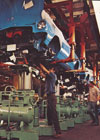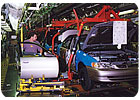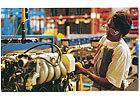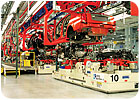GM’s assembly philosophy has evolved over the last 40 years.

During the last 4 decades, General Motors Corp. (GM, Detroit) has opened more than 20 new assembly plants around the world. The company embarked on an ambitious building spree in the 1980s as part of an unprecedented $40 billion capital spending program.
New plants cropped up in Bowling Green, KY; Detroit/Hamtramck, MI; Fairfax, KS; Orion, MI; Roanoke, IN; Spring Hill, TN; and Wentzville, MO. Joint-venture plants opened in Fremont, CA, and Ingersoll, ON. General Motors also invested $2 billion in a European expansion program that included a new engine plant in Aspern, Austria, and new assembly plants in Eisenach, Germany, and Zaragoza, Spain.
Many of the plants featured new production ideas and technologies, such as electric (rather than hydraulic) robots, modular paint systems and just-in-time material flow. In 1982, GM launched a major campaign to increase productivity through automation.
Two years later, the company announced its “Factory of the Future” project. The ambitious goal was to increase robot deployment from just 302 units in 1980 to 14,000 by the end of the decade. When the Detroit-Hamtramck plant opened in the mid-1980s, it featured 2,000 programmable devices, including 260 robots
General Motors also invested millions of dollars in state-of-the-art machining systems and material handling equipment. For instance, GM’s Oshawa, ON, plant purchased several hundred automated guided vehicles for use in engine dress, trim and chassis lines.
Here’s a look at four trendsetting GM facilities that have opened in the United States since Richard Nixon was president.

When it opened in 1970, Lordstown was touted as the mosted automated automotive plant in the world.
Lordstown
General Motors spent more than $75 million retooling its Lordstown, OH, plant in the late 1960s to produce the new Chevrolet Vega. The subcompact sedan was aimed at imports, which were slowly trickling into the United States.When it opened in 1970, Lordstown was touted as the most automated automotive plant in the world. Thanks to computer-controlled automation, it boasted the fastest assembly lines in the auto industry. The new factory could assemble more than 100 vehicles per hour vs. 55 to 60 cars at other auto plants.
More than 90 percent of body welding operations were automated vs. 20 percent to 40 percent at traditional auto plants. The state-of-the-art Lordstown plant featured 75 automatic welding devices, including 26 five-axis Unimate robots that each performed about 20 spot welds.
“Each can move a welding tool through a predetermined series of motions to provide weld accuracy within 1/16 inch,” reported a feature article in the October 1970 issue of ASSEMBLY. “Each Unimate memorizes the exact ‘point-in-space’ location for each weld position. On command, it accurately repeats the pattern of tool movements and produces 2,000 welds per hour.”
Engineers also harnessed information technology to simplify assembly line operations for greater efficiency and accuracy. A computerized system was used to balance workloads along the assembly lines that built the innovative Vega sedan.
“The system allows individual operators enough time to do a job correctly, which minimizes line disruptions and out-of-station repairs,” reported ASSEMBLY. “When options or model mixes change, the computer can immediately rebalance the line for the new conditions.”
Simulation was used extensively to optimize assembly operations. Critical systems and major subassemblies were assembled thousands of times in a computer through the use of mathematical models. Dimensional tolerances, fixturing and assembly sequence were predicted for a large number of units before a single vehicle was actually built at Lordstown.
Manufacturing engineers focused on two main objectives: make the task of the assembly line employee easier and simplify the approach to quality control. The Vega used 43 percent fewer body parts than the Chevy Impala. For instance, the Vega used only 1,231 individual pieces vs. 3,500 for the Impala.
To meet cost objectives, four different models of the Vega 2300-a hatchback, a wagon, a two-door sedan and a panel van-were built on a single, final assembly line. All four bodies shared the same hood, bolt-on fenders, engine compartment and front-end panels to minimize both parts and variables in assembly operations.
“Fewer parts mean fewer assembly operations, less chance for assembly errors and a potentially higher online quality level, all without sacrificing body strength and passenger safety,” explained ASSEMBLY. “Fewer parts require fewer joints, fewer seals and reduce the possibility of water leaks.”
While automation was hailed as a success at Lordstown, the plant quickly became a hotbed of labor unrest. Multiple work stoppages culminated in a bitter strike in the early 1970s. Today, Lordstown assemblers build the Chevy Cobalt and the Pontiac G5, and it is one of GM’s most productive plants.

The NUMMI plant ushered in a bold new era in the U.S. auto industry.
NUMMI
In 1983, GM and Toyota Motor Corp. (Nagoya, Japan) created a joint-venture called New United Motor Manufacturing Inc. (NUMMI). The new operation was set up in a 20-year-old GM plant in Fremont, CA, that was plagued with problems. Because of poor employee morale and low productivity, assembly costs were much higher than at any other GM facility. The plant, which formerly made Buicks, was revamped according to the Toyota Production System (TPS).At the time, the radical venture created a great deal of criticism from other automakers and from the United Auto Workers (UAW) union. Other automakers worried that the two giants might create a cartel or a monopoly. The UAW was concerned that American autoworkers would lose jobs in a nonunion assembly plant. Executives from NUMMI claimed that the strategic partnership would foster innovative labor relations and create several hundred U.S. jobs.
After months of investigation, the Federal Trade Commission finally approved the joint venture. But, it capped GM’s allotment of vehicles from the plant at just 250,000 a year. It also restricted communication between executives at GM and Toyota. The companies were forbidden to talk about pricing and other marketing strategies.
Toyota provided the management for the plant, which would produce small, Toyota-designed vehicles for the U.S. market, while GM provided much of the hourly labor. Most of the parts were shipped from Japan. Many of the former GM operators were sent to Japan to learn about andon boards, continuous improvement, kaizen, standardized work and other key aspects of TPS.
The UAW cooperated to make lean production possible. More than 75 percent of NUMMI’s workforce was comprised of operators who formerly worked at the GM-run plant. However, instead of the traditional union contract comprised of page after page of narrowly defined job categories, the NUMMI contract provided for only two categories of workers-assemblers and technicians.
The NUMMI plant ushered in a bold new era in the U.S. auto industry. Unlike traditional plants, all employees wore the same uniforms, including management. Another unique aspect of NUMMI was a new metal stamping plant that was built adjacent to the body shop. That allowed body panels to be stamped in small lots just as they were needed. The old Fremont facility relied on parts that were shipped by rail from GM stamping plants in the Midwest.
The joint venture eventually proved to be a success. The first NUMMI automobile, a Chevy Nova, rolled off the line in December 1984. Assemblers began building the Toyota Corolla in September 1986. Within 5 years, NUMMI operated as efficiently as Toyota’s Japanese plants.
A few years after NUMMI production began, GM teamed up with Suzuki Motor Corp. (Hamamatsu, Japan) to build small cars and sport utility vehicles. The CAMI Automotive Inc. (Ingersoll, ON) assembly line opened in 1989.
The NUMMI plant pioneered just-in-time inventory and parts replenishment, assembly line quality control through kaizen, an emphasis on teamwork that required multiple skills, and close cooperation between operators and management. Today, it continues to assemble Corolla sedans, in addition to the Pontiac Vibe crossover and the Toyota Tacoma pickup truck.

Because the Spring Hill plant was so flexible, assemblers build both standard and high-performance engines on the same line.
Spring Hill
A “new kind of assembly plant” cropped up in a field 30 miles south of Nashville, TN, in the mid-1980s. Production of Saturn sedans began at Spring Hill in July 1990.During the 1980s, GM spent 8 years and $3 billion dollars developing a new brand and a different way of building small cars to compete against Japanese automakers. The goal was to use start-to-finish innovation, such as plastic body panels, to produce a sporty family of subcompact sedans.
According to GM chairman Roger Smith, Saturn would be “the key to GM’s long-term competitiveness, survival and success as a domestic producer. We expect it to be a learning laboratory. We also expect that what we learn with Saturn will spread throughout GM.”
The Spring Hill plant served as an incubator for several cutting-edge ideas. One of the most radical new concepts was the role of labor and management. As a result, the plant boasted of having the lowest absentee rate in the auto industry.
“Saturn represents a profound change in the relationship between the union and management, and an equally profound change in the way that GM manages its people,” proclaimed an article in the January 1991 issue of ASSEMBLY. “Instead of a traditional labor contract, GM and the UAW have developed an on-going memorandum of agreement that establishes a full partnership between [the two organizations]. This memo is based on the premise that people are the most valuable asset at Saturn and it defines a framework for consensus decision-making that is truly unique in the U.S. auto industry.”
Self-directed work teams, each comprised of six to 15 members, formed the basic building block of the Saturn manufacturing organization. Each team was empowered with the authority to take action on their decisions. They interviewed and hired new team members, developed production systems, and selected production equipment and suppliers.
The Spring Hill plant was also flexible. Assemblers built both standard and high-performance engines on the same line, in addition to producing both manual and automatic transmissions. Instead of using traditional dedicated production equipment, 40 percent of the assembly tooling was shared between the manual and automatic transmissions in the assembly process. This flexibility enabled the plant to respond quickly to changing market conditions and customer demand.
The most significant departure from conventional assembly methods at the new Saturn plant was the skillet conveyor system. “Derived from SKId + paLLET, the skillet is a moving platform that carries both the work and the work team, emulating a stop-station in that it allows the workers to remain stationary while working,” explained the ASSEMBLY article. “The skillet system was discovered at GM’s Russelsheim facility in Germany and its use at Saturn is the first application in the U.S.”
More than 50 percent of the assembly operations at Spring Hill, including the cockpit subassembly, door subassembly and vehicle final assembly, were done on skillets. ASSEMBLY claimed that the skillet system had many advantages over traditional chain-on-end conveyor systems.
For instance, it was “ergonomically advantageous in that the operators never have to chase their jobs down the line. The skillet moves at about 14 feet per minute, giving the team members anywhere from 4.5 to 6 minutes to perform a group of operations, instead of 30 seconds as would be the case on a traditional assembly line. Each skillet also has a lift so that operators can raise or lower the car to the position most comfortable and convenient for them to work on.”
General Motors engineers also made extensive efforts to ensure that the assembly tooling and processes were user friendly and ergonomically sound. For example, electric power tools were used wherever possible to eliminate air exhaust noise and oil mist, and to minimize torque reaction on the operator.
Battery-powered tools were also used for some fastening applications to eliminate power cords, tool carriers and balancers. Final assembly was done doors-off to give operators easy access to the interior for installing carpet, seats, internal trim and the cockpit.
The Spring Hill plant is still one of GM’s largest facilities, but it never came close to its original goal of expanding to produce 500,000 vehicles annually. It recently underwent an $800 million overhaul. The plant is scheduled to start building the new Chevrolet Traverse crossover in September.

Lansing Grand River incorporated a variety of advanced manufacturing processes and asembly techniques to speed product flow, improve quality and reduce time to market.
Grand River
The Lansing Grand River facility, which opened in January 2002, was the first all-new factory built by GM in the United States since the Saturn complex in Spring Hill. It was also the company’s first plant built in the 21st century.Unlike other GM plants, the flexible facility was capable of building cars and trucks simultaneously. It also served as a showcase for the latest lean manufacturing practices gleaned from GM facilities overseas. When it opened, GM executives predicted that the new Lansing plant would be 20 percent to 30 percent more efficient in assembling vehicles than traditional plants.
“This is the most significant auto industry plant in the last 25 years,” proclaimed an article in the April 2002 issue of ASSEMBLY. “It’s as state of the art as anything you’ll find in the world. With its emphasis on lean and agile manufacturing, Lansing Grand River represents a paradigm change in the industry.”
During the previous 15 years, GM invested heavily in assembly plants overseas. Lansing Grand River was based on lessons learned from facilities in Argentina, Brazil, China, Germany, Poland and Thailand. It featured a fast and flexible production system that could easily respond to ever-changing marketplace demand.
The facility was built on the site of 19 demolished buildings that were among the original, 100-year-old Oldsmobile complex. It was approximately one-half the size of the plants constructed during GM’s building spree in the 1980s. For instance, the facility used 1.9 million square feet vs. 3.5 million square feet for the Detroit-Hamtramck plant that opened in 1985.
The $560 million Lansing Grand River plant also cost about half as much as similar-sized manufacturing facilities. Because it was built differently than older plants, it could pay for itself in only 15 years.
Unlike traditional car plants, which are typically housed under one roof, Lansing Grand River consists of three separate buildings-a body shop, a paint shop and a general assembly building-connected by conveyors. The T-shaped plant configuration allowed architects and engineers to create multiple loading docks on all sides of the plant to facilitate just-in-time parts delivery from off-site suppliers. It also emphasizes the role of assembly, body and paint as discrete and highly focused business units.
The buildings were shrink-wrapped around the various manufacturing processes. That configuration allows for efficient material flow and provides an optimum layout for operators.
In addition, Lansing Grand River incorporated a wide variety of advanced manufacturing processes and assembly techniques to speed product flow, improve quality and reduce time to market.
The general assembly building is extremely bright, with extra wide aisles and high ceilings. There are very few forklift trucks, but scores of automated guided vehicles. Overhead electronic boards monitor the production heartbeat of the facility. Nothing is stacked more than 5 feet high to maintain a clear line of vision throughout the plant.
Lansing Grand River was also the first GM facility to use the company’s programmable adaptable assembly system in full production. The time-saving system is programmed to adjust to different body styles, such as cars, trucks and sport utility vehicles, from job to job on the same line.
When it opened, the body shop boasted of having 338 programmable welding robots that apply 2,163 welds per vehicle. Today, the Lansing Grand River plant assembles the Cadillac CTS, SRX and STS.
Two Factory Concepts that Failed
General Motors has continually pushed the envelope in developing new production concepts. However, not all of the company’s assembly ideas have succeeded.In the fall of 1986, GM began producing axles at its Vanguard plant in Saginaw, MI. It was a test facility that used advanced automation ideas. The controversial “factory of the future” was set up to employ only 42 hourly workers on two shifts, and none on its third shift.
At the time, the plant was hailed as being among the most technologically advanced in the world. It included 12 assembly cells and more than 50 robots. Material handling systems included automated guided vehicles and an automated storage and retrieval system.
During tests in 1987, the plant managed to change over from production of one axle design to another in less than 10 minutes. The following year, the facility started assembling axles and components for actual use in GM production vehicles.
The initial goal was to develop a lights-out factory, but the trendsetting plant closed quietly in August 1992. Although the lights-out goal was never reached, some techniques developed at Saginaw Vanguard were eventually transferred to other GM plants.
In the late 1990s, GM embarked on “Project Yellowstone,” which focused on modular assembly. The goal was to build a new plant in Lordstown, OH, that would be based on the recently opened Blue Macaw small-car facility in Gravatai, Brazil.
Under Project Yellowstone, many GM plants in the United States would only focus on the final assembly of vehicles, with suppliers building modular subassemblies, such as suspension systems. Some assembly plants would be staffed by suppliers, who would also have played a key role in product development.
“Modular wouldn’t just mean modification changes to an existing structure of production, but a radical change in the entire way that vehicles were put together,” claimed Buzz Hargrove, president of the Canadian Auto Workers union.
Another plan called for extensive use of information technology similar to Dell Computer’s successful build-on-demand concept. For instance, cameras would be installed on assembly lines to allow customers to see their vehicles being built.
Labor unions were appalled by Project Yellowstone and threatened to strike. That quickly put an end to the modular assembly concept. But, the Brazilian plant that inspired it is still going strong.
The Buick City Legacy
In early 1983, General Motors embarked on a unique experiment aimed at transforming one of the oldest automotive assembly plants in the world into a state-of-the-art facility. The $300 million project rehabbed several old component manufacturing and assembly plants in Flint, MI. Some of the buildings dated back to the early days of GM.
The 123-acre complex, comprised of plants formerly operated by AC Spark Plug, Buick and Fisher Body, was scheduled to be shuttered. However, a group of Buick managers and union leaders devised a bold plan to save the assembly operations. They sold GM’s top management on their idea, which involved grouping smaller plants around the central Buick assembly plant.
The vertically integrated complex, called Buick City, was patterned after Toyota City in Japan. The goal was to apply lean manufacturing principles, such as kanban and sequential, just-in-time parts delivery, to save money.
Buick City would produce the same volume as much larger GM plants in only one-third the amount of space. And, unlike the automaker’s other final assembly plants, the new complex included dedicated engine, powertrain and metal stamping facilities.
Major changes to the 7-building site included the transformation of the assembly line to produce all-new front-wheel-drive automobiles for the 1986 model year. An electronic communication system was used to ensure timely delivery of material within 200 feet of its point of use. Instead of traditional 5 to 6-day stockpiles, inventories were reduced to 4 hours.
Assembly lines were replenished by automated guided vehicles. In addition, many assembly tasks were done at stop stations, where a team of operators worked on a specific task. Assemblers were no longer required to chase the line to do their jobs. The remodeled plant also used 250 state-of-the-art robots.
The Buick City concept extended the life of the aging assembly facility by nearly 15 years and temporarily saved 4,000 jobs. Along the way, the plant became the world leader in quality. In fact, J.D. Power and Associates (Westlake Village, CA) awarded Buick City its Platinum Award in 1999, recognizing it as the highest quality producing automotive plant in the world. Ironically, that same year, the last Buick LeSabre rolled off the line.
Many of the buildings were eventually razed and leveled. However, Buick City served as a benchmark for several other GM plants, such as assembly facilities in Fairfax, KS, and Oshawa, ON. Today, a portion of the site houses a GM engine and powertrain plant.
The 123-acre complex, comprised of plants formerly operated by AC Spark Plug, Buick and Fisher Body, was scheduled to be shuttered. However, a group of Buick managers and union leaders devised a bold plan to save the assembly operations. They sold GM’s top management on their idea, which involved grouping smaller plants around the central Buick assembly plant.
The vertically integrated complex, called Buick City, was patterned after Toyota City in Japan. The goal was to apply lean manufacturing principles, such as kanban and sequential, just-in-time parts delivery, to save money.
Buick City would produce the same volume as much larger GM plants in only one-third the amount of space. And, unlike the automaker’s other final assembly plants, the new complex included dedicated engine, powertrain and metal stamping facilities.
Major changes to the 7-building site included the transformation of the assembly line to produce all-new front-wheel-drive automobiles for the 1986 model year. An electronic communication system was used to ensure timely delivery of material within 200 feet of its point of use. Instead of traditional 5 to 6-day stockpiles, inventories were reduced to 4 hours.
Assembly lines were replenished by automated guided vehicles. In addition, many assembly tasks were done at stop stations, where a team of operators worked on a specific task. Assemblers were no longer required to chase the line to do their jobs. The remodeled plant also used 250 state-of-the-art robots.
The Buick City concept extended the life of the aging assembly facility by nearly 15 years and temporarily saved 4,000 jobs. Along the way, the plant became the world leader in quality. In fact, J.D. Power and Associates (Westlake Village, CA) awarded Buick City its Platinum Award in 1999, recognizing it as the highest quality producing automotive plant in the world. Ironically, that same year, the last Buick LeSabre rolled off the line.
Many of the buildings were eventually razed and leveled. However, Buick City served as a benchmark for several other GM plants, such as assembly facilities in Fairfax, KS, and Oshawa, ON. Today, a portion of the site houses a GM engine and powertrain plant.
Click GM Centennial: Production Powerhouse to view a slideshow of GM plants and production processes through the years.

